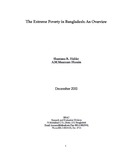| dc.contributor.author | Halder, Shantana R. | |
| dc.contributor.author | Husain, A.M.Muazzam | |
| dc.date.accessioned | 2019-08-28T07:48:48Z | |
| dc.date.available | 2019-08-28T07:48:48Z | |
| dc.date.issued | 2000-12 | |
| dc.identifier.citation | Halder, S. R., & Husain, A. M. M. (2000). The extreme poverty in Bangladesh: an overview. Research Reports (2000), Economic Studies, (XVI), 1–9. | en_US |
| dc.identifier.uri | http://hdl.handle.net/10361/12503 | |
| dc.description.abstract | By reviewing existing literature this report focuses on methodological issues related to the
identification of ultra poor in Bangladesh. According to different statistics up to 40% of the
rural poor in Bangladesh remains uncovered by any micro-credit initiatives. Extreme poor
consists of 30-40% of that population. Extreme poor are of two types. It includes destitutes
and those who are physically fit for work but unable to consume more than 1805 kilo
calories per person per day. The extent of extreme poverty and its actual number varies
depending upon the methods used for calculation. Since there is no universally accepted
definition on extreme poverty, it also creates another problem in its measurement. It is
revealed from the findings of different studies that a single criterion is not enough to identify
the extreme poor. In this regard a combination of variables highly correlated with poverty
like household landholding, household head's sex, education and occupation and village level
vibrancy can be a better choice. | en_US |
| dc.language.iso | en | en_US |
| dc.publisher | Research and Evaluation Division, Brac | en_US |
| dc.subject | NGOs | en_US |
| dc.subject.lcsh | Poverty--Bangladesh. | |
| dc.title | The extreme poverty in Bangladesh: an overview | en_US |
| dc.type | Research report | en_US |

